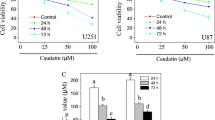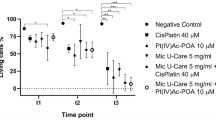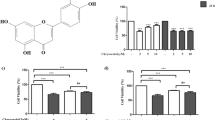Abstract
Glioblastoma is the most malignant human brain tumor that shows poor response to existing therapeutic agents. Search continues for an effective therapy for controlling this deadliest brain tumor. Curcumin (CCM), a polyphenolic compound from Curcuma longa, possesses anti-cancer properties in both in vitro and in vivo. In the present investigation, we evaluated the therapeutic efficacy of CCM against human malignant glioblastoma U87MG cells. Trypan blue dye exclusion test showed decreased viability of U87MG cells with increasing dose of CCM. Wright staining and ApopTag assay, respectively, showed the morphological and biochemical features of apoptosis in U87MG cells treated with 25 μM and 50 μM of CCM for 24 h. Western blotting showed activation of caspase-8, cleavage of Bid to tBid, increase in Bax:Bcl-2 ratio, and release of cytochrome c from mitochondria followed by activation of caspase-9 and caspase-3 for apoptosis. Also, CCM treatments increased cytosolic level of Smac/Diablo to suppress the inhibitor-of-apoptosis proteins and down regulated anti-apoptotic nuclear factor kappa B (NFκB), favoring the apoptosis. Increased activities of calpain and caspase-3 cleaved 270 kDa α-spectrin at specific sites generating 145 kDa spectrin break down product (SBDP) and 120 kDa SBDP, respectively, leading to apoptosis in U87MG cells. Results show that CCM is an effective therapeutic agent for suppression of anti-apoptotic factors and activation of calpain and caspase proteolytic cascades for apoptosis in human malignant glioblastoma cells.







Similar content being viewed by others
References
Greenlee RT, Murray T, Bolden S et al (2000) Cancer statistics, 2000. CA Cancer J Clin 50:7–33
Teicher BA, Menon K, Alvarez E et al (2001) Antiangiogenic and antitumor effects of a protein kinase Cβ inhibitor in human T98G glioblastoma multiforme xenografts. Clin Cancer Res 7:634–640
Phuong LK, Allen C, Peng KW et al (2003) Use of a vaccine strain of measles virus genetically engineered to produce carcinoembryonic antigen as a novel therapeutic agent against glioblastoma multiforme. Cancer Res 63:2462–2469
Eitel K, Wagenknecht B, Weller M (1999) Inhibition of drug-induced DNA fragmentation, but not cell death, of glioma cells by non-caspase protease inhibitors. Cancer Lett 142:11–16
Koul D, Takada Y, Shen R et al (2006) PTEN enhances TNF-induced apoptosis through modulation of nuclear factor kappa B signaling pathway in human glioma cells. Biochem Biophys Res Commun 350:463–471
Jaattela M (2004) Multiple cell death pathways as regulators of tumour initiation and progression. Oncogene 23:2746–2756
Nagane M, Levitzki A, Gazit A et al (1998) Drug resistance of human glioblastoma cells conferred by a tumor-specific mutant epidermal growth factor receptor through modulation of Bcl-xL and caspase-3-like proteases. Proc Natl Acad Sci USA 95:5724–5729
Blanquicett C, Gillespie GY, Nabors LB et al (2002) Induction of thymidine phosphorylase in both irradiated and shielded, contralateral human U87MG glioma xenografts: implications for a dual modality treatment using capecitabine and irradiation. Mol Cancer Ther 1:1139–1145
Dalen H, Neuzil J (2003) α-Tocopheryl succinate sensitises a T lymphoma cell line to TRAIL-induced apoptosis by suppressing NFκB activation. Br J Cancer 88:153–158
Biswas DK, Martin KJ, McAlister C et al (2003) Apoptosis caused by chemotherapeutic inhibition of nuclear factor kappa B activation. Cancer Res 63:290–295
Pennarun G, Granotier C, Gauthier LR et al (2005) Apoptosis related to telomere instability and cell cycle alterations in human glioma cells treated by new highly selective G-quadruplex ligands. Oncogene 24:2917–2928
Shervington A, Cruickshanks N, Wright H et al (2006) Glioma: what is the role of c-Myc, hsp90 and telomerase? Mol Cell Biochem 283:1–9
von Haefen C, Wieder T, Essmann F et al (2003) Paclitaxel-induced apoptosis in BJAB cells proceeds via a death receptor-independent, caspases-3/-8-driven mitochondrial amplification loop. Oncogene 22:2236–2247
Kim R (2005) Recent advances in understanding the cell death pathways activated by anticancer therapy. Cancer 103:1551–1560
Earnshaw WC (1999) Apoptosis: A cellular poison cupboard. Nature 397:387–389
Stennicke HR, Jurgensmeier JM, Shin H, et al (1998) Pro-caspase-3 is a major physiologic target of caspase-8. J Biol Chem 273:27084–27090
Desagher S, Osen-Sand A, Nichols A et al (1999) Bid-induced conformational change of Bax is responsible for mitochondrial cytochrome c release during apoptosis. J Cell Biol 144:891–901
Orrenius S (2004) Mitochondrial regulation of apoptotic cell death. Toxicol Lett 149:19–23
Hasenjager A, Gillissen B, Muller A et al (2004) Smac induces cytochrome c release and apoptosis independently from Bax/Bcl-xL in a strictly caspase-3-dependent manner in human carcinoma cells. Oncogene 23:4523–4535
Kroemer G, Reed JC (2000) Mitochondrial control of cell death. Nat Med 6:513–519
Goyal L (2001) Cell death inhibition: keeping caspases in check. Cell 104:805–808
Moore JD, Rothwell NJ, Gibson RM (2002) Involvement of caspases and calpains in cerebrocortical neuronal cell death is stimulus-dependent. Br J Pharmacol 135:1069–1077
Sakahira H, Enari M, Nagata S (1998) Cleavage of CAD inhibitor in CAD activation and DNA degradation during apoptosis. Nature 391:96–99
Cregan SP, Dawson VL, Slack RS (2004) Role of AIF in caspase-dependent and caspase-independent cell death. Oncogene 23:2785–2796
Fimognari C, Nusse M, Cesari R et al (2002) Growth inhibition, cell-cycle arrest and apoptosis in human T-cell leukemia by the isothiocyanate sulforaphane. Carcinogenesis 23:581–586
Kelloff GJ, Crowell JA, Steele VE et al (2000) Progress in cancer chemoprevention: development of diet-derived chemopreventive agents. J Nutr 130:467S–471S
Karunagaran D, Rashmi R, Kumar TR (2005) Induction of apoptosis by curcumin and its implications for cancer therapy. Curr Cancer Drug Targets 5:117–129
Karmakar S, Banik NL, Patel SJ et al (2006) Curcumin activated both receptor-mediated and mitochondria-mediated proteolytic pathways for apoptosis in human glioblastoma T98G cells. Neurosci Lett 407:53–58
Roy M, Chakraborty S, Siddiqi M et al (2002) Induction of Apoptosis in Tumor Cells by Natural Phenolic Compounds. Asian Pac J Cancer Prev 3:61–67
Li L, Aggarwal BB, Shishodia S et al (2004) NFκB and IκBα kinase are constitutively active in human pancreatic cells, and their down-regulation by curcumin (diferuloylmethane) is associated with the suppression of proliferation and the induction of apoptosis. Cancer 101:2351–2362
Woo JH, Kim YH, Choi YJ et al (2003) Molecular mechanisms of curcumin-induced cytotoxicity: induction of apoptosis through generation of reactive oxygen species, down regulation of Bcl-xL and IAP, the release of cytochrome c and inhibition of Akt. Carcinogenesis 24:1199–1208
Bae JH, Park JW, Kwon TK (2003) Ruthenium red, inhibitor of mitochondrial Ca2+ uniporter, inhibits curcumin-induced apoptosis via the prevention of intracellular Ca2+ depletion and cytochrome c release. Biochem Biophys Res Commun 303:1073–1079
Anto RJ, Mukhopadhyay A, Denning K et al (2002) Curcumin (diferuloylmethane) induces apoptosis through activation of caspase-8, Bid cleavage, and cytochrome c release: its suppression by ectopic expression of Bcl-2 and Bcl-xL. Carcinogenesis 23:143–150
Duvoix A, Blasius R, Delhalle S et al (2005) Chemopreventive and therapeutic effects of curcumin. Cancer Lett 223:181–190
Notarbartolo M, Poma P, Perri D et al (2005) Anti-tumor effects of curcumin, alone or in combination with cisplatin or doxorubicin, on human hepatic cancer cells. Analysis of their possible relationship to changes in NFκB activation levels and in IAP gene expression. Cancer Lett 224: 53–65
Chakrabarti AK, Yoshida Y, Powers JM et al (1988) Calcium-activated neutral proteinase in rat brain myelin and subcellular fractions. J Neurosci Res 20:351–358
Karmakar S, Weinberg MS, Banik NL et al (2006) Activation of multiple molecular mechanisms for apoptosis in human malignant glioblastoma T98G and U87MG cells treated with sulforaphane. Neuroscience 141:1265–1280
Ray SK, Karmakar S, Nowak MW et al (2006) Inhibition of calpain and caspase-3 prevented apoptosis and preserved electrophysiological properties of voltage-gated and ligand-gated ion channels in rat primary cortical neurons exposed to glutamate. Neuroscience 139:577–595
Gavrieli Y, Sherman Y, Ben-Sasson SA (1992) Identification of programmed cell death in situ via specific labeling of nuclear DNA fragmentation. J Cell Biol 119:493–501
Seligman AM, Karnovsky MJ, Wasserkrug HL et al (1968) Nondroplet ultrastructural demonstration of cytochrome oxidase activity with a polymerizing osmiophilic reagent, diaminobenzidine (DAB). J Cell Biol 38:1–14
Karmakar S, Banik NL, Patel SJ et al (2007) Garlic compounds induced calpain and intrinsic caspase cascade for apoptosis in human malignant neuroblastoma SH-SY5Y cells. Apoptosis 12:671–684
Karmakar S, Banik NL, Patel SJ et al (2007) 5-Aminolevulinic acid-based photodynamic therapy suppressed survival factors and activated proteases for apoptosis in human glioblastoma U87MG cells. Neurosci Lett 415:242–247
Laemmli UK (1970) Cleavage of structural proteins during the assembly of the head of bacteriophage T4. Nature 227:680–685
Ashkenazi A, Dixit VM (1998) Death receptors: signaling and modulation. Science 281:1305–1308
Gross A, Yin XM, Wang K et al (1999) Caspase cleaved Bid targets mitochondria and is required for cytochrome c release, while Bcl-xL prevents this release but not tumor necrosis factor-R1/Fas death. J Biol Chem 274:1156–1163
Chakraborty S, Ghosh U, Bhattacharyya NP et al (2006) Inhibition of telomerase activity and induction of apoptosis by curcumin in K562 cells. Mutat Res 596:81–90
Sen S, Sharma H, Singh N (2005) Curcumin enhances Vinorelbine mediated apoptosis in NSCLC cells by the mitochondrial pathway. Biochem Biophys Res Commun 331:1245–1252
Shi M, Cai Q, Yao L (2006) Antiproliferation and apoptosis induced by curcumin in human ovarian cancer cells. Cell Biol Int 30:221–226
Hussain AR, Al-Rasheed M, Manogaran PS et al (2006) Curcumin induces apoptosis via inhibition of PI3-kinase/Akt pathway in acute T cell leukemias. Apoptosis 11:245–254
Deeb DD, Jiang H, Gao X et al (2005) Chemosensitization of hormone-refractory prostate cancer cells by curcumin to TRAIL-induced apoptosis. J Exp Ther Oncol 5:81–91
Dai Z, Zhu WG, Morrison CD et al (2003) A comprehensive search for DNA amplification in lung cancer identifies inhibitors of apoptosis cIAP1 and cIAP2 as candidate oncogenes. Hum Mol Genet 12:791–801
Tomita M, Kawakami H, Uchihara JN et al (2006) Curcumin (diferuloylmethane) inhibits constitutive active NFκB, leading to suppression of cell growth of human T-cell leukemia virus type I-infected T-cell lines and primary adult T-cell leukemia cells. Int J Cancer 118:765–772
Magalska A, Sliwinska M, Szczepanowska J et al (2006) Resistance to apoptosis of HCW-2 cells can be overcome by curcumin- or vincristine-induced mitotic catastrophe. Int J Cancer 119:1811–1818
Rashmi R, Kumar S, Karunagaran D (2004) Ectopic expression of Hsp70 confers resistance and silencing its expression sensitizes human colon cancer cells to curcumin-induced apoptosis. Carcinogenesis 25:179–187
Verhagen AM, Ekert PG, Pakusch M et al (2000) Identification of Diablo, a mammalian protein that promotes apoptosis by binding to and antagonizing IAP proteins. Cell 102:43–53
Wilkinson JC, Wilkinson AS, Scott FL (2004) Neutralization of Smac/Diablo by inhibitors of apoptosis (IAPs). A caspase-independent mechanism for apoptotic inhibition. J Biol Chem 279:51082–51090
Adrain C, Creagh EM, Martin SJ (1996) Apoptosis-associated release of Smac/Diablo from mitochondria requires active caspases and is blocked by Bcl-2. EMBO J 20:6627–6636
Roy N, Deveraux QL, Takahashi R et al (1997) The cIAP1 and cIAP2 proteins are direct inhibitors of specific caspases. EMBO J 16:6914–6925
LaCasse EC, Baird S, Korneluk RG et al (1998) The inhibitors of apoptosis (IAPs) and their emerging role in cancer. Oncogene 17:3247–3259
Deveraux QL, Reed JC (1999) IAP family proteins-suppressors of apoptosis. Genes Dev 13:239–252
Beg AA, Baltimore D (1996) An essential role for NFκB in preventing TNF-α-induced cell death. Science 274:782–784
Mitsiades N, Mitsiades CS, Poulaki V et al (2002) Biologic sequelae of nuclear factor kappa B blockade in multiple myeloma: therapeutic applications. Blood 99:4079–4086
Zou T, Rao JN, Guo X et al (2004) NFκB-mediated IAP expression induces resistance of intestinal epithelial cells to apoptosis after polyamine depletion. Am J Physiol Cell Physiol 286:C1009–C1018
Jeremias I, Kupatt C, Baumann B et al (1998) Inhibition of nuclear factor kappa B activation attenuates apoptosis resistance in lymphoid cells. Blood 91:4624–4631
Wang CY, Mayo MW, Korneluk RG et al (1998) NFκB anti-apoptosis: induction of TRAF1 and TRAF2 and cIAP1 and cIAP2 to suppress caspase-8 activation. Science 281:1680–1683
Bharti AC, Donato N, Singh S et al (2003) Curcumin (diferuloylmethane) down-regulates the constitutive activation of NFκB and IκBα kinase in human multiple myeloma cells, leading to suppression of proliferation and induction of apoptosis. Blood 101:1053–1062
Aggarwal S, Ichikawa H, Takada Y et al (2006) Curcumin (diferuloylmethane) down-regulates expression of cell proliferation and antiapoptotic and metastatic gene products through suppression of IκBα kinase and Akt activation. Mol Pharmacol 69:195–206
Du C, Fang M, Li Y et al (2000) Smac, a mitochondrial protein that promotes cytochrome c-dependent caspase activation by eliminating IAP inhibition. Cell 102:33–42
Rashmi R, Kumar S, Karunagaran D (2005) Human colon cancer cells lacking Bax resist curcumin-induced apoptosis and Bax requirement is dispensable with ectopic expression of Smac or downregulation of Bcl-xL. Carcinogenesis 26:713–723
Rashmi R, Kumar S, Karunagaran D (2004) Ectopic expression of Hsp70 confers resistance and silencing its expression sensitizes human colon cancer cells to curcumin-induced apoptosis. Carcinogenesis 25:179–187
Takano J, Tomioka M, Tsubuki S et al (2005) Calpain mediates excitotoxic DNA fragmentation via mitochondrial pathways in adult brains: evidence from calpastatin mutant mice. J Biol Chem 280:16175–16184
Nath R, Raser KJ, Stafford D et al (1996) Non-erythroid α-spectrin breakdown by calpain and interleukin 1β-converting-enzyme-like protease(s) in apoptotic cells: contributory roles of both protease families in neuronal apoptosis. Biochem J 319:683–690
Wang KK, Posmantur R, Nath R et al (1998) Simultaneous degradation of αII- and βII-spectrin by caspase 3 (CPP32) in apoptotic cells. J Biol Chem 273:22490–22497
Neumar RW, Xu YA, Gada H et al (2003) Cross-talk between calpain and caspase proteolytic systems during neuronal apoptosis. J Biol Chem 278:14162–14167
Acknowledgements
This work was supported in part by the R01 grants (CA-91460 and NS-57811) from the National Institutes of Health (Bethesda, MD, USA) and by the Spinal Cord Injury Research Fund (SCIRF-0803) from the State of South Carolina to S.K.R.
Author information
Authors and Affiliations
Corresponding author
Additional information
Special issue in honor of Naren Banik.
Rights and permissions
About this article
Cite this article
Karmakar, S., Banik, N.L. & Ray, S.K. Curcumin Suppressed Anti-apoptotic Signals and Activated Cysteine Proteases for Apoptosis in Human Malignant Glioblastoma U87MG Cells. Neurochem Res 32, 2103–2113 (2007). https://doi.org/10.1007/s11064-007-9376-z
Received:
Accepted:
Published:
Issue Date:
DOI: https://doi.org/10.1007/s11064-007-9376-z




